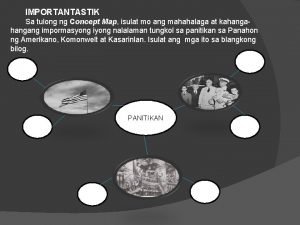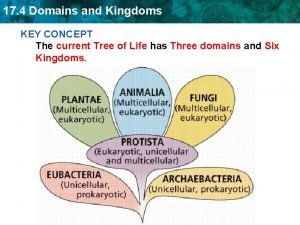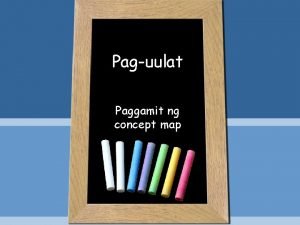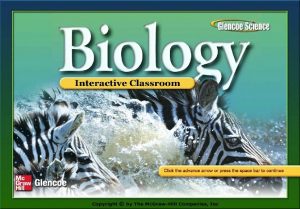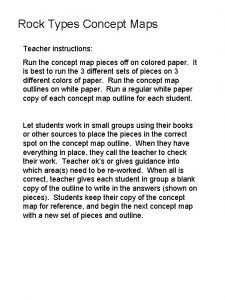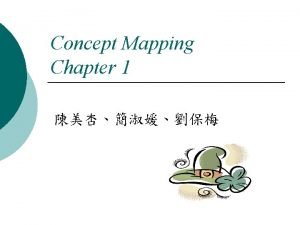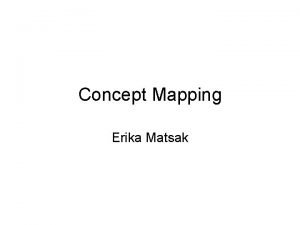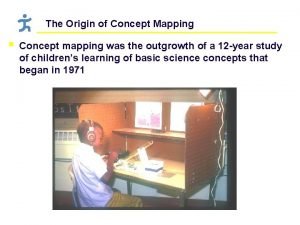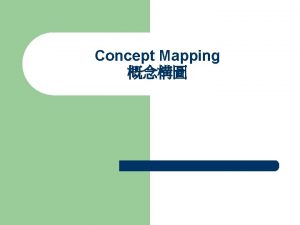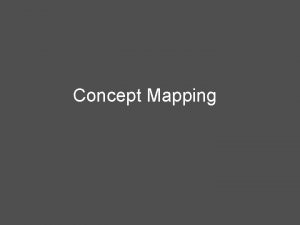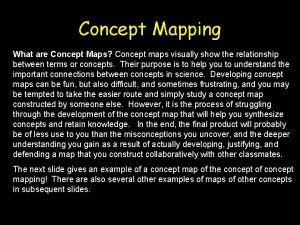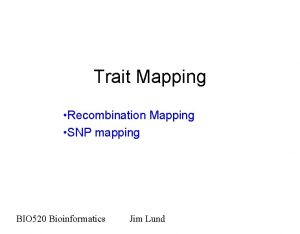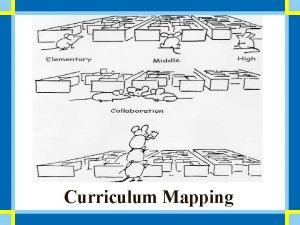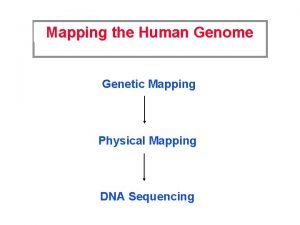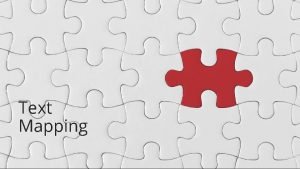Concept Mapping What is Concept Mapping A concept












- Slides: 12


Concept Mapping What is Concept Mapping? A concept map (also called webbing and graphic organizer) is a method to link related ideas graphically as a means of developing a fuller definition of a person, a term, or an idea (Novak, 1998). Novak, J. D. (1998). Learning, creating, and using knowledge: Concept Maps as facilitative tools in schools and corporations. Mahwah, NJ: Lawrence Erlbaum Associates.

How do you build a concept map? • Start with a focus question that addresses a problem, issue, or idea you wish to map. • Identify 10 to 20 concepts (no more than three words in length) that are important to the question and list them. • Rank order the concepts by placing the most inclusive idea at the top. – It is helpful to focus on the essential question to help you determine the rank order of the words. – Sometimes this part of the process leads to a modification of the focus question or the writing of a new focus question. • Work down the list and add new words as needed.

Concept Map Building Continued: • Begin to build your map by placing the most inclusive idea at the top. – Usually has just, this is one. – You may have no more than two or three at the top of the map. • Next, select the two, three, or four sub-concepts to place under each general concept. – Avoid placing more than four concepts under any other concept. – If more, identify another term that would fit as an intermediate idea. • Connect the concepts by lines. – Use arrows, sometimes in both directions, to demonstrate a flow of thought.

Concept Map Building Continued: • Label the lines with one or a few linking words. • Using linking words, define the relationship between the two concepts so that it is a valid statement. • Begin to see a structure of meaning for the ideas you are linking. • Rework the structure of your map, which may include – Adding, subtracting, or changing concepts – Repeating the process several times – Learning new ideas and gaining new insights

Concept Map Building Continued: • Look for cross links between concepts in different sections of the map and label these lines. – Cross links help you see new, creative relationships in your developing knowledge. • Add specific examples to the concept labels. – Ford Mustang is a specific example of a type of car.

Concept Map Building Continued: • Concept maps may be developed into many different forms for the same set of concepts. • There is no one way to draw a concept map. • As your knowledge and understanding evolves, so will your concept maps.

Sample Concept Map in Development – Stage One

Sample Concept Map in Development – Stage Two

Sample Concept Map in Development – Stage Three

Benefits of Concept Mapping • Enables students and teachers to identify what a learner already knows, along with misconceptions, and helps them to anchor the learning of new concepts and principles. • Enables students to identify the key concepts and principles in activities, readings, and lectures. • Enables students to personally construct their vision of events and objects as they learn about them. • Enables students to transform their tacit knowledge into clear and concise explanations.

For more information Reference: Novak, J. D. (1998). Learning, creating, and using knowledge: Concept Maps as facilitative tools in schools and corporations. Mahwah, NJ: Lawrence Erlbaum Associates.
 Terjemahan
Terjemahan Memory parameters
Memory parameters Forward mapping vs backward mapping
Forward mapping vs backward mapping Concept map tungkol sa pananaliksik
Concept map tungkol sa pananaliksik Chapter 34 circulation in humans concept mapping answer key
Chapter 34 circulation in humans concept mapping answer key Chapter 10 section 1 meiosis
Chapter 10 section 1 meiosis Domains and kingdoms
Domains and kingdoms Gawain 4 graphic organizer concept map
Gawain 4 graphic organizer concept map Chapter 34 section 1 the circulatory system
Chapter 34 section 1 the circulatory system Concept map tutorial
Concept map tutorial Concept mapping chapter 28 fishes and amphibians
Concept mapping chapter 28 fishes and amphibians Concept mapping of the different rock types
Concept mapping of the different rock types Mitosis vs meiosis concept map
Mitosis vs meiosis concept map



